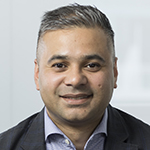

#IHeartHIT, our yearlong storytelling initiative, helps shine a light on the human side of health information and technology and the impact it can have on the health and wellness of every person, everywhere. Read one story below and consider sharing yours.
It was decided that I was going to become a doctor the day I was born. My hard-working middle-class family did not want to risk my future and carefully planned a path for me. I grew up in Pakistan, still a developing country, and was happy to embrace a career in healthcare.
But while I was going through my medical training, I recognized that the health system was completely and utterly helpless in dealing with the high burden of disease, poor access to timely care and no safety net for the poor.
I was excited to get exposure to public health planning as part of a presidential task force on health in Pakistan which propelled me to the Master of Public Health program at Harvard. I took many courses focused on quality improvement and healthcare economics during this time. That was the first time I became enamored with the idea that you can use the data that is generated in healthcare systems for research and care improvements without requiring long research cycles.
RELATED: A Powerful Reminder of How Health IT Improves Patient Safety
My first role in health IT was working on a team that built clinical workflows for physicians and nurses. I had to find the right balance between putting comprehensive data collection forms in front of clinicians while recognizing that they are in a rush to get to the more important things, like treating patients. I have now worked on deploying and improving EHRs at over 50 hospitals across the U.S., Canada, U.K. and Singapore.
I have lived in the health IT space for the large majority of my professional career and I’m grateful for that.
I love hearing success stories, like one hospital that had strong results against sepsis. The signs of sepsis vary, so constantly monitoring and evaluating patient data can help identify the condition faster. They saw an over 30% reduction in sepsis with the use of an early warning system in their EHR.
An EHR is just one type of many solutions that can implement protocols that save lives. I’m inspired by what is achieved with clinical decision support and population health management. I love working in health IT.
The views and opinions expressed in this blog or by commenters are those of the author and do not necessarily reflect the official policy or position of HIMSS or its affiliates.
Join Us as We Reimagine Health Through Information and Technology
At HIMSS, our vision is to realize the full health potential of every human, everywhere. Be part of the community that’s transforming the global health ecosystem with courage, curiosity and determination.



